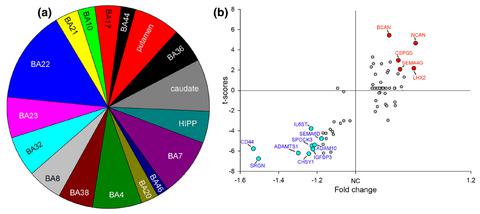当前位置:
X-MOL 学术
›
Eur. J. Nerosci.
›
论文详情
Our official English website, www.x-mol.net, welcomes your feedback! (Note: you will need to create a separate account there.)
Molecular signature of extracellular matrix pathology in schizophrenia
European Journal of Neroscience ( IF 3.4 ) Pub Date : 2020-10-18 , DOI: 10.1111/ejn.15009 Harry Pantazopoulos 1 , Pavel Katsel 2, 3, 4 , Vahram Haroutunian 2, 3, 4 , Gabriele Chelini 5, 6 , Torsten Klengel 6, 7, 8 , Sabina Berretta 5, 6, 9
European Journal of Neroscience ( IF 3.4 ) Pub Date : 2020-10-18 , DOI: 10.1111/ejn.15009 Harry Pantazopoulos 1 , Pavel Katsel 2, 3, 4 , Vahram Haroutunian 2, 3, 4 , Gabriele Chelini 5, 6 , Torsten Klengel 6, 7, 8 , Sabina Berretta 5, 6, 9
Affiliation

|
Growing evidence points to a critical involvement of the extracellular matrix (ECM) in the pathophysiology of schizophrenia (SZ). Decreases of perineuronal nets (PNNs) and altered expression of chondroitin sulphate proteoglycans (CSPGs) in glial cells have been identified in several brain regions. GWAS data have identified several SZ vulnerability variants of genes encoding for ECM molecules. Given the potential relevance of ECM functions to the pathophysiology of this disorder, it is necessary to understand the extent of ECM changes across brain regions, their region- and sex-specificity and which ECM components contribute to these changes. We tested the hypothesis that the expression of genes encoding for ECM molecules may be broadly disrupted in SZ across several cortical and subcortical brain regions and include key ECM components as well as factors such as ECM posttranslational modifications and regulator factors. Gene expression profiling of 14 neocortical brain regions, caudate, putamen and hippocampus from control subjects (n = 14/region) and subjects with SZ (n = 16/region) was conducted using Affymetrix microarray analysis. Analysis across brain regions revealed widespread dysregulation of ECM gene expression in cortical and subcortical brain regions in SZ, impacting several ECM functional key components. SRGN, CD44, ADAMTS1, ADAM10, BCAN, NCAN and SEMA4G showed some of the most robust changes. Region-, sex- and age-specific gene expression patterns and correlation with cognitive scores were also detected. Taken together, these findings contribute to emerging evidence for large-scale ECM dysregulation in SZ and point to molecular pathways involved in PNN decreases, glial cell dysfunction and cognitive impairment in SZ.
中文翻译:

精神分裂症细胞外基质病理的分子特征
越来越多的证据表明细胞外基质 (ECM) 在精神分裂症 (SZ) 的病理生理学中具有重要作用。在几个大脑区域已经发现神经胶质细胞中神经周网络 (PNN) 的减少和硫酸软骨素蛋白聚糖 (CSPG) 的表达改变。GWAS 数据已经确定了几个 ECM 分子编码基因的 SZ 脆弱性变体。鉴于 ECM 功能与这种疾病的病理生理学的潜在相关性,有必要了解整个大脑区域的 ECM 变化程度、它们的区域和性别特异性以及哪些 ECM 成分导致了这些变化。我们检验了这样一个假设,即编码 ECM 分子的基因的表达可能在 SZ 中的几个皮质和皮质下大脑区域被广泛破坏,并且包括关键的 ECM 成分以及 ECM 翻译后修饰和调节因子等因素。来自对照受试者的 14 个新皮质大脑区域、尾状核、壳核和海马的基因表达谱(n = 14/区域)和患有 SZ 的受试者(n = 16/区域)使用 Affymetrix 微阵列分析进行。对大脑区域的分析揭示了 SZ 皮质和皮质下大脑区域 ECM 基因表达的普遍失调,影响了几个 ECM 功能的关键组件。SRGN、CD44、ADAMTS1、ADAM10、BCAN、NCAN 和 SEMA4G 显示出一些最强劲的变化。还检测了区域、性别和年龄特异性基因表达模式以及与认知评分的相关性。综上所述,这些发现为 SZ 中大规模 ECM 失调提供了新的证据,并指出了 SZ 中 PNN 减少、神经胶质细胞功能障碍和认知障碍所涉及的分子途径。
更新日期:2020-10-18
中文翻译:

精神分裂症细胞外基质病理的分子特征
越来越多的证据表明细胞外基质 (ECM) 在精神分裂症 (SZ) 的病理生理学中具有重要作用。在几个大脑区域已经发现神经胶质细胞中神经周网络 (PNN) 的减少和硫酸软骨素蛋白聚糖 (CSPG) 的表达改变。GWAS 数据已经确定了几个 ECM 分子编码基因的 SZ 脆弱性变体。鉴于 ECM 功能与这种疾病的病理生理学的潜在相关性,有必要了解整个大脑区域的 ECM 变化程度、它们的区域和性别特异性以及哪些 ECM 成分导致了这些变化。我们检验了这样一个假设,即编码 ECM 分子的基因的表达可能在 SZ 中的几个皮质和皮质下大脑区域被广泛破坏,并且包括关键的 ECM 成分以及 ECM 翻译后修饰和调节因子等因素。来自对照受试者的 14 个新皮质大脑区域、尾状核、壳核和海马的基因表达谱(n = 14/区域)和患有 SZ 的受试者(n = 16/区域)使用 Affymetrix 微阵列分析进行。对大脑区域的分析揭示了 SZ 皮质和皮质下大脑区域 ECM 基因表达的普遍失调,影响了几个 ECM 功能的关键组件。SRGN、CD44、ADAMTS1、ADAM10、BCAN、NCAN 和 SEMA4G 显示出一些最强劲的变化。还检测了区域、性别和年龄特异性基因表达模式以及与认知评分的相关性。综上所述,这些发现为 SZ 中大规模 ECM 失调提供了新的证据,并指出了 SZ 中 PNN 减少、神经胶质细胞功能障碍和认知障碍所涉及的分子途径。



























 京公网安备 11010802027423号
京公网安备 11010802027423号